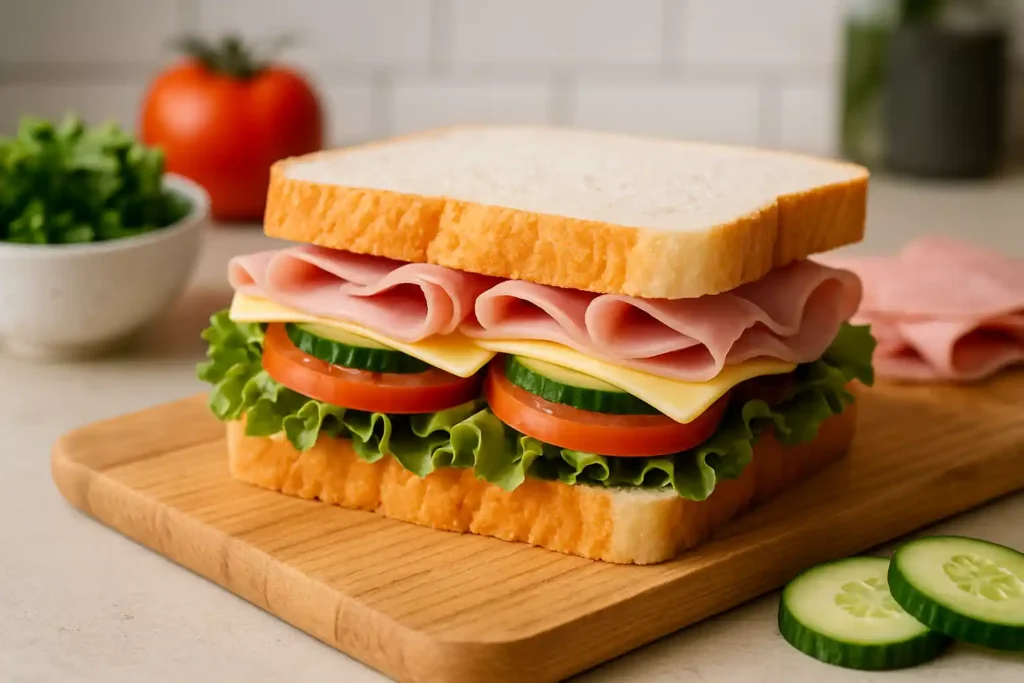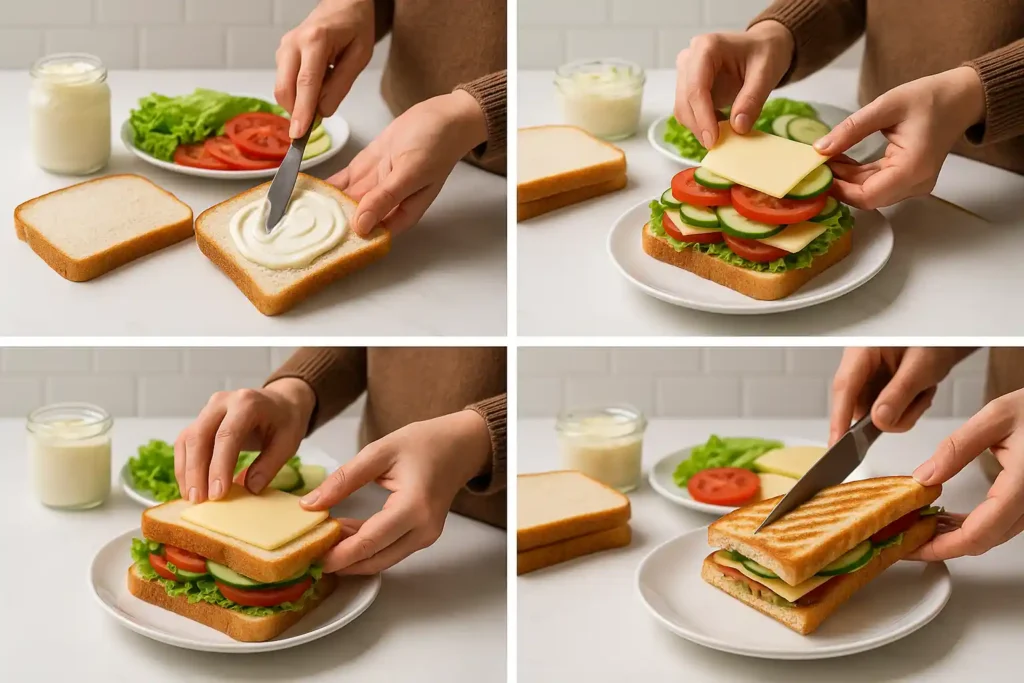What is a Bread Sandwich?
Ever wondered what exactly a bread sandwich is? Simply put, it’s a delightful creation where slices of bread embrace a variety of fillings, turning simple ingredients into a scrumptious meal. Whether you’re grabbing a quick lunch or crafting something special, learning a bread sandwich recipe opens doors to endless tasty possibilities.

Popular Types of Bread for Sandwiches
Choosing the right bread types for sandwiches can make or break your delicious creation. From crusty sourdough to soft white bread, each variety offers a unique texture and flavor that complements your fillings. For a soft and perfect loaf that elevates your sandwich, check out this soft and perfect loaf bread recipe. To explore more, you might want to peek into some popular sandwich breads that many enthusiasts swear by.
Basic Bread Varieties and Selection Tips
The foundation of any spectacular sandwich lies in the bread. When selecting, think about texture—do you want fluffy or dense? Flavor—mild or tangy? For starters, classic white, whole wheat, rye, or multigrain are excellent choices. If you’re interested in making homemade bread, this making homemade bread guide is a treasure trove of wisdom. Remember, the best sandwich bread provides both flavor and structural support to your fillings.
Common Fillings and Spreads
Fillings bring life to your bread sandwich recipe. Popular spreads such as mayonnaise, mustard, or green chutney add moisture and zest. Fresh vegetables like tomato and cucumber bring crunch and freshness, while proteins like cheese, turkey, or hummus bulk up the nutrition. Looking for healthy ingredients for sandwiches? This guide on nutritious sandwich fillings is just right for you.
Step 1: Gather All Ingredients and Supplies
First things first! Grab your bread slices, selected fillings, spreads, a clean knife, and a cutting board. Having everything within reach makes the process smoother and more enjoyable. Think of this as setting the stage for your sandwich masterpiece.
Step 2: Prepare the Bread
Start by laying your chosen bread on the cutting board. If you prefer, lightly toast the slices for a crispier texture, or keep them fresh and soft. Trimming crusts is optional, depending on your preference. Properly prepping the bread ensures it’s ready to hold your fillings without falling apart.
Step 3: Apply Spreads Evenly
Use a knife to generously spread mayonnaise, mustard, butter, or green chutney evenly over one or both slices of bread. Even spreading avoids dry bites and complements the fillings perfectly. It’s like setting a flavorful base coat for your sandwich canvas.
Step 4: Add Fresh Vegetables or Fillings
Layer your fillings carefully—start with crisp cucumber slices, then add juicy tomato, leafy lettuce, and your choice of protein like cheese or deli meats. The secret to a great sandwich lies in balancing textures and flavors, creating a harmonious bite every time.
Step 5: Assemble and Press the Sandwich
Place one slice atop the other, fillings sandwiched between breads. Press gently but firmly to compact everything neatly; this prevents fillings from spilling out and helps the sandwich hold its shape when eating.
Step 6: Cut the Sandwich for Serving
Using a sharp knife, cut the sandwich diagonally or straight down the middle. Triangle slices can feel a bit fancy, while rectangles are classic and neat. How you cut affects not only presentation but also ease of eating.
Step 7: Optional – Toast or Grill Your Sandwich
Want a warm, melty experience? Toast or grill your sandwich until the bread is golden and fillings warm. This step adds extra crunch and blend of flavors—turning your simple bread sandwich into a gourmet treat.

Popular Vegetable and Protein Additions
Spruce up your sandwich by adding bell peppers, shredded carrots, or sprouts for crunch. Protein-wise, try grilled chicken, boiled eggs, or even tofu for plant-based power. If you need more creative inspiration, explore these energizing morning ideas for vibrant fillings that boost your sandwich’s nutrition and taste.
Using Different Spreads and Sauces
Experiment beyond the usual mayo! Think avocado spread, hummus, pesto, or a zingy sriracha mayo to amp up flavor.
Toasting vs. Fresh – What Works Best?
Toasting offers crunch and warmth, while fresh retains bread’s soft texture. Your choice depends on mood and meal occasion—why not try both? A toasted sandwich has a totally different vibe than a fresh vegetable sandwich.
How to Pack a Sandwich for Lunch or Travel
Keep your sandwiches fresh by wrapping them tightly in parchment or using reusable containers. To avoid sogginess, pack soggy ingredients separately. For the best packing techniques, read through how to pack sandwiches for travel and improve your lunch game.
Overloading or Underfilling
Too much or too little filling can ruin your sandwich experience. Overstuffed sandwiches become messy, while underfilled ones feel disappointing. Aim for a balance where every bite has a perfect proportion of sandwich fillings.
Using Soggy or Stale Bread
Stale bread leads to a dry or tough sandwich, while soggy bread will collapse and make your hands messy. Always pick freshly baked bread or toast it slightly. For tips to prevent soggy sandwiches, check out these sandwich moisture control techniques.
Uneven Spreading or Improper Layering
Uneven spread means dry patches; improper layering causes fillings to slip. Spread spreads fully and layer fillings from sturdy to delicate for the best results.
Best Side Dishes and Snacks
Pair your sandwich with fresh fruit, crunchy veggie sticks, or a crisp salad for a delightful meal. Explore these nutritious pairings that complement your sandwich perfectly.
Sauces and Dips to Enhance Flavor
A side of aioli, ranch dip, or even a spicy chutney can turn your sandwich meal into a flavor fiesta. Dipping adds an extra layer of excitement, especially for grilled or toasted varieties.
FAQs
What bread is best for making sandwiches?
Choosing the best bread depends on your taste and sandwich type. Soft white or whole wheat breads offer a mild flavor and tender texture, perfect for everyday sandwiches. Hearty breads like sourdough or rye give a tangy twist and hold up well with robust fillings. Some prefer multigrain for added texture and nutrition. Ultimately, the best bread supports fillings without getting soggy or overpowering flavors.
How can I prevent my sandwich from becoming soggy?
Prevent soggy sandwiches by spreading butter or cream cheese on the bread first; these act as moisture barriers. Pack wet ingredients, like tomatoes or pickles, separately and assemble just before eating. Using firmer breads and toasting them also helps maintain a crisp texture. For more, check out these tips to prevent soggy sandwiches.
Can I make a bread sandwich without toasting the bread?
Absolutely! Many bread sandwich recipes call for fresh, untoasted bread. This keeps your sandwich soft and fresh, ideal for delicate fillings like cucumber and tomato or soft cheeses. However, toasting adds crunch and warmth if you prefer.
What are some healthy fillings for a bread sandwich?
Healthy fillings include fresh veggies like leafy greens, tomatoes, and cucumbers, lean proteins such as grilled chicken or turkey, and spreads like hummus or avocado. These options provide nutrients without packed fats or excess calories. Ideas for good sandwich fillings are detailed further here.
How do I pack a bread sandwich to keep it fresh for lunch?
Use airtight containers or wrap your sandwich tightly in parchment paper or reusable wraps. Avoid soggy ingredients or pack them separately, assembling just before eating. Keeping your sandwich cool with an ice pack helps maintain freshness. Learn more about the best ways to pack sandwiches to enjoy a perfect lunch anytime.
Conclusion
Making a bread sandwich step by step is straightforward and endlessly customizable. By selecting the right bread, applying spreads evenly, adding fresh fillings, and assembling carefully, anyone can create delicious sandwiches that fit any meal or mood. Avoid common pitfalls like stale bread or uneven layering, and you’ll ensure perfect taste and texture every time. Don’t shy away from experimenting with spreads, fillings, and toasting options—this is how your perfect sandwich skills take flight!
